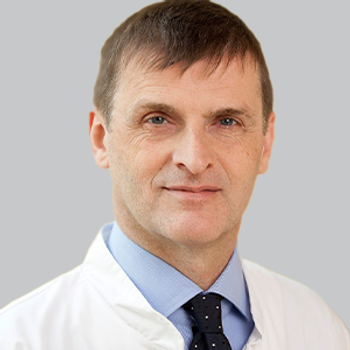
PML Monitoring and Educating Technicians

Scott D. Newsome, DO, MSCS, FAAN: What caught my attention with the MAGNIMS [Magnetic Resonance Imaging in Multiple Sclerosis] guidelines that we don’t have in the CMSC [Consortium of Multiple Sclerosis Centers] guidelines is that for patients who are on medications that have had an association with PML [progressive multifocal leukoencephalopathy], there is ongoing monitoring even beyond a certain period. Meaning that I started questioning myself after someone’s been stable on a medication let’s say for 10 years, and we talked about possibly backing off on doing that monitoring, every couple years, every few years. Now I’m starting to question that because it has that safety risk of PML, and we know catching PML earlier is better for the patient, that I’ve stepped back, and I’ve started to do yearly even in that context. Someone who’s been very stable is a solid guideline. I don’t know if that’s….
Anthony Traboulsee, MD, FRCPC: I think it’s an important thing to address because the therapies keep broadening in terms of how they impact MS [multiple sclerosis] but also their risk profiles. I think we need to always be conscious of new safety concerns and modify the guidelines on a regular basis to reflect current technology or changes in technology, and changes in medications that we’re using for treating patients with MS.
June Halper, MSN, APC-C, MSCN, FAAN: With the PML, with the requisition to the radiologist, do you have concerns in terms of if you monitor…?
Scott D. Newsome, DO, MSCS, FAAN: The rule out is like you don’t want to say more.
June Halper, MSN, APC-C, MSCN, FAAN: No.
Frederik Barkhof, MD, PhD: PML monitoring.
June Halper, MSN, APC-C, MSCN, FAAN: Monitoring? OK. Do you have to add what drugs they’re on or just the PML monitoring?
Frederik Barkhof, MD, PhD: No, that shouldn’t matter. The appearance will be similar.
David Li, MD, FRCPC: I was just going to say that, not so much with respect to the PML monitoring, but in terms of trying to address the issue about when a patient changes to a different place and you have different scans. One of the things that brings us to the core of the meeting yesterday was in terms of making it more widely used. I think that’s an issue that we faced with these guidelines. They’ve been in existence since 2001 when we had our first meeting, and we’ve had meetings subsequently. We’ve always worked with the aim that these guidelines would be useful for the patient, for the physicians, for the practitioner, and that they would be usable so that they could be used within the scanners that you have.
But our biggest problem is making them used by people. That’s probably 1 of the major things that we’ve been trying to do at the meeting yesterday was really discuss how we can make it more widely used. This is because, you can imagine that the patient may be able to carry their scans with them, and then they move to a new place. If they’re using different techniques and different things, even that may make it difficult. If the scans can be done the same way in as many places as possible, then it becomes….
Frederik Barkhof, MD, PhD: It becomes less of an issue if they move scanner or move facilities, I agree.
David Li, MD, FRCPC: Yes.
June Halper, MSN, APC-C, MSCN, FAAN: Right. But then also we’re trying to teach the radiologists when the clinicians had to order. But the bottom line is who does it—it’s the technician. We heard that loud and clear yesterday. A colleague from your center was telling me, “We’ve got to educate those people at the frontline,” which is at the machine. There was some suggestion of a card, just like they have McDonald Criteria on a card, something where the technician can be trained and understand. When you do a clinical trial, you train the technician, right? Maybe this is a little bit different than a clinical trial, but put them in the picture, too, because they need to understand.
Scott D. Newsome, DO, MSCS, FAAN: It definitely surrounds education, and I think it’s important to educate all people involved from top down. I think what’s nice about having guidelines, and you mentioned this, having a core set of sequences that these are the bare minimum, and having that uploaded into a scanner.
Frederik Barkhof, MD, PhD: In the scanner, so you don’t have to think all the time. You can just push the
button, white matter disease, or MS, MS follow-up, or PML follow-up, and you always get these core sequences. Obviously, you can add things according to local preferences or to adjust to the individual patient or the particular question being asked. But at least you always have the same core sequences.
Scott D. Newsome, DO, MSCS, FAAN: That will help the clinical care, and then all the bells and whistles, of course. I’m a big believer in trying to get more sequences, if you can, even if it’s not going to influence clinical care today. This is because, over time, I think you could go back from a research perspective and look at that longitudinally, whether it’s the central vein sign, if your facility has that. Although this makes me think about time in the machine, at least in the United States, is money.
June Halper, MSN, APC-C, MSCN, FAAN It’s money, right?
Scott D. Newsome, DO, MSCS, FAAN: Right. I’ve heard from some of the colleagues yesterday that there’s a specific lump sum that’s given for the scanner. This is all you get, and so you’re trying to whittle down what you can do in a short period of time so you can do more people within an hour. That’s a real concern worldwide.
June Halper, MSN, APC-C, MSCN, FAAN: Oh, absolutely. In Europe, do they have that same concern about time is money?
Frederik Barkhof, MD, PhD: Definitely. We actually try to bring our protocols sequence time under 15 minutes or even 10 minutes if we can so that you have 15 minutes, 20 minutes table time. You have to make tough choices. Some things are really nice to do, like a 3-D T1 image to try to look at atrophy over time. But given the uncertainties around measuring atrophy, we often skip that sequence. The same thing is around spinal cord imaging. Quite often I get requests for monitoring patients on treatment and get a request for brain plus spine. Usually doing the spine repeatedly doesn’t yield that much, but it takes an enormous amount of time. It easily adds 20 minutes to 25 minutes to the exam, whereas most of the activity is detected from the brain scans anyway. We have to be really restrictive in requesting follow-up spine scans. There are clearly situations. If you have unexplained symptoms that are clearly clinically attributable to the spine and you may think of alternative pathology, you have to do it. But just for routine monitoring, the yield is extremely low, yet takes more time than a brain scan.
Newsletter
Keep your finger on the pulse of neurology—subscribe to NeurologyLive for expert interviews, new data, and breakthrough treatment updates.









































